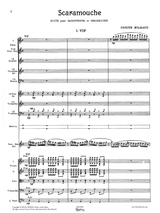One of Milhaud's most well known pieces is 'Scaramouche'. Original written as a Suite for two pianos but later transcribed by the composer for Alto Saxophone and Orchestra.
The original conception for the Scaramouche suite was for piano duo, and Milhaud found writing for this medium particularly troublesome. Within a few years, Milhaud rearranged the piece for saxophone and orchestra and later for clarinet and orchestra which was performed by the alleged “king of swing”, Benny Goodman. Scaramouche was partly based upon incidental music written for Molière's play Le médecin volant, which was performed at the 'Theâtre Scaramouche', hence the work's title. A scaramouch was a stock character in such commedia dell ‘arte, the character being a boastful coward. There is a lightheartedness about this music, but it is well crafted and the infectious rhythms and simple melodies made it one of Milhaud's most popular works.
The first, lively movement features subtle bitonality, which was one of Milhaud's favourite harmonic techniques. Although bitonality often conjures up thoughts of Stravinskian dissonance, here the bitonality is used in a comparatively consonant manner. This is achieved partly through the diatonic melody which acts as a stable thread throughout the movement. Milhaud was slightly influenced by jazz, particularly after his first trip to the USA, in which he visited the jazz clubs of Harlem. We can hear this influence in the initial chord progression, which we now recognize as 'rhythm changes'. In one sense, the subsequent reharmonizations also exhibit a jazz influence, specifically in the use of slash chords, however, the piece is firmly grounded in the French classical tradition. The movement is in ternary form, as indeed are the other two movements, with the principle melody left mostly unchanged upon its return. Although Milhaud integrated musics from outside Western Art Music, he always did so with a tasteful sensibility, avoiding the clumsy crossover bilge so often heard today.
The second movement is notable for little other than its simplistic beauty. The well-crafted melody is strong and provides an appropriate platform for dialogue with the piano. The B section switches to compound time before the return of the main melody, this time with more contrapuntal accompaniment.
In 1917, Milhaud accompanied his colleague, Paul Claudel the renowned poet and ambassador to Brazil, as his secretary. It was here that Milhaud was first exposed to Latin American rhythms, which became a significant influence in much of his work. Here in the Brazileira we here overt references to clavé as Milhaud pays homage to the Samba. The middle section is characterized by rapid scalic passages before a harmonic gear change up a minor third. As with the previous two movements, the prevailing sonority throughout is major and the piece ends with a jubilant restatement of the initial melody.
- Difficulty:
- Intermediate/Advanced
- Instrumentation:
- 2Fl1dPicc, 2Ob, 2Cl, 2Bsn, 2Hn, 2Tpt, 2Tbn, Perc, Alto Sax, Strings
- Duration:
- 10 minutes
- Set of Parts:
- Includes Strings count 5.5.4.4.3
- Product Type:
- REPRINT SERIES







